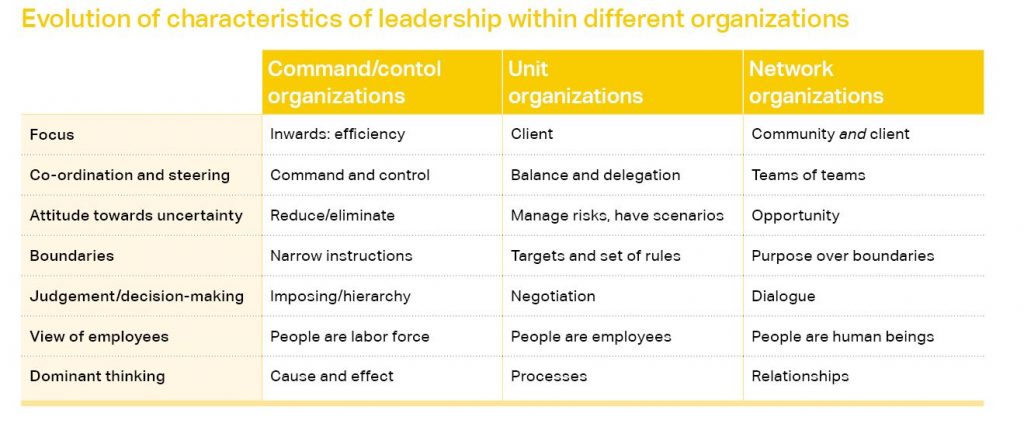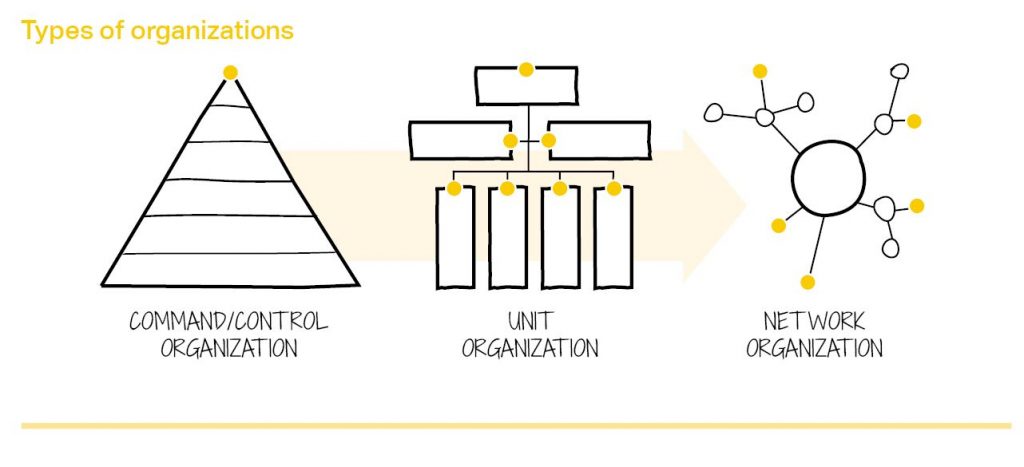
Organizations are developing more and more into fleets of self-organizing teams. To be successful, a high-level framework for an overview of an organization’s evolution and its corresponding leadership styles is essential. Changed leadership needs require different roles and mindsets as well as a new set of competences.
Organizations have evolved from simple closed systems with a hierarchical top towards more complex systems. Defining (business) units was the first answer to handle upcoming complexity. At the moment, more and more organizations are developing into fleets of self-organizing teams with open boundaries to other organizations in the supply chain. This development is the natural answer to the increase in complexity within and outside the organization. The development from command and control type of organizations via unit organizations towards network organizations* also has an impact on the characteristics of impactful leadership inside those organizations (see chart).
Changing characteristics of leadership
Hierarchy and power have a different meaning in all three typologies described above. In a network organization, power is no longer centralized or deliberately dispersed over units. Hierarchy is gone and power becomes a fuzzy process with changing coalitions. This change requires extra flexibility and tolerance for ambiguity from all of the stakeholders. The table below shows the most important changes in the characteristics of leadership as well as the shift in orientation over the years.
Is this the end of leadership?
Not at all. Charismatic leadership is called for as never before, but a new set of competences is needed. Leadership theories have evolved significantly over the past decades. As a starting point, researchers tried to grasp the essential traits necessary for good leadership to turn it into theories of transformational leadership. In a majority of these models, the leaders play a central role in influencing the organization. Leaders do, create, empower, act, trust, etc. – focusing on the action centricity of leadership.
How do these approaches fit into network organizations where everything is about decentralization, the evolution of teams, having space for dialogue and collective decision-making? How can a leader provide positive impact in an environment like this? Transforming the traditional workflow is an easy step; many tools can be applied to an organization. The most significant change is on the mindset level – for both leaders and employees alike. Enabling agility requires a certain attitude. It demands an open, self-reflective and learning approach as well as the ability to learn from difficult situations. You need to lower control, tolerate uncertainty, trust people, and be open to adaptations. Leading teams towards more agility calls for leadership by role instead of position and works best with humbleness and service-orientation. Imagine a sentence like »I do not know, we have to find out« in a traditional environment and compare it to an agile one. Empowering and involving those who might know better to come up with solutions is key. This leads to actions like asking questions and listening closely rather than giving all the answers. For many, this is quite a shift. Give up power, enable participation, invite self-organization, creativity and cooperation, to gain what? You will evolve from controlling to empowering and a one-man/ woman-show will turn into shared responsibility. It will definitely change your role from supervising to setting the framework and defining your way of working – eyes-on, but hands-off.
Winning perspectives
In a world of fast changes and hyper-connected developments, leaders can no longer rely solely on their own information and knowledge to make good decisions. Complex challenges can be tackled more effectively with a collective problem-solving approach, involving the know-how and experience of as many in the organization as needed. Many employees have more direct access to information than their leaders. Sometimes they are very close to an obstructive business problem or have other ideas about how to solve open tasks.
To create the best results for an organization, a leader’s task is to enable the team-members to make in their best contributions. If you believe that good ideas can evolve in any part of the organization, structure and leadership must facilitate participation. This new approach dismisses micromanagement and control as well as a certain degree of power and status. In return, it brings involvement and accountability. Leadership is less connected to specific individuals and is now becoming a role, a function.
How to develop as a leader
Some levers for leadership towards agility:
Work on your purpose
It is always an energizing moment during leadership development programs when participants gain clarity about their personal purpose and see how all those individual purposes eventually connect through the team and organizational purpose. Teams make a step towards becoming communities; team objectives start to serve a broader purpose.
Provide time and space for communities to form
People need to connect. Accelerate personal links by allocating time and space for them, or invite your employees to connect with each other and with their partners outside the organization.
Open up the space for accountability
Energy can be boosted and development can be selfdriven if employees are given the chance to decide what should be improved in their everyday work. It is always fascinating to see how much energy is unleashed every time top management steps back and opens up the space for employees to run development initiatives.
Let things evolve and happen
Leaders should not do much and just let things happen: connect your people and teams will support each other in their objectives and in serving the customer together, without getting trenched in narrow team objectives. Your task here is basically to let them do their work.
Reflect, learn and adapt
Spend time frequently looking back on achievements and learnings as well as looking ahead at priorities for the future. Take it to the next level and share this with your team. Finding out what was supportive and what hindered is not your task as a leader. Just ensure a process where employees and partners in the network can do the work and provide feedback.
Presence, attention and relationships
Looking at the points above, it might seem that a leader shouldn’t do much anymore. It would, however, be a big mistake to spend your time behind your laptop. Being present and approachable for people inside and outside the organization is very important. Give your attention, listen, and work on relationships with and between people.
Organize decision-making
Don’t take over decision-making, but make sure to empower those who have the information to make decisions. Your task as a leader is to set up a process that clarifies who decides what in which situation.
Is it there or will it grow?
Some lucky organizations carry agility in their DNA; most organizations develop and grow these abilities through continuous development. The same applies for leaders: for some, it is very natural to lead like this, while others struggle. The most difficult challenge is a transition from one stage to another. During a transition phase, confusion and ambiguity increase as the »old« behavioral patterns are not valid anymore and the new ones have not proven their efficiency yet. They might also feel »uncomfortable.« In this phase, leaders have to find their authenticity within the new framework, and this takes time. Being out of the comfort zone requires extra energy, so it is important to support your leaders in their transition. Provide time in the management team and among peers to exchange their thoughts about the new leadership approach. Appreciate what is already there and works well, because it is not all new.
And encourage the sharing of little success stories.
»A change in role and mindset helps to overcome the limitations of classical management principles.«
* These three stages and the translation into leadership characteristics were inspired by the article »Leiderschap in Netwerken«, written by Boris van de Woestijne and Henk Folkerts in Rijnconsult Business Review (2014).



